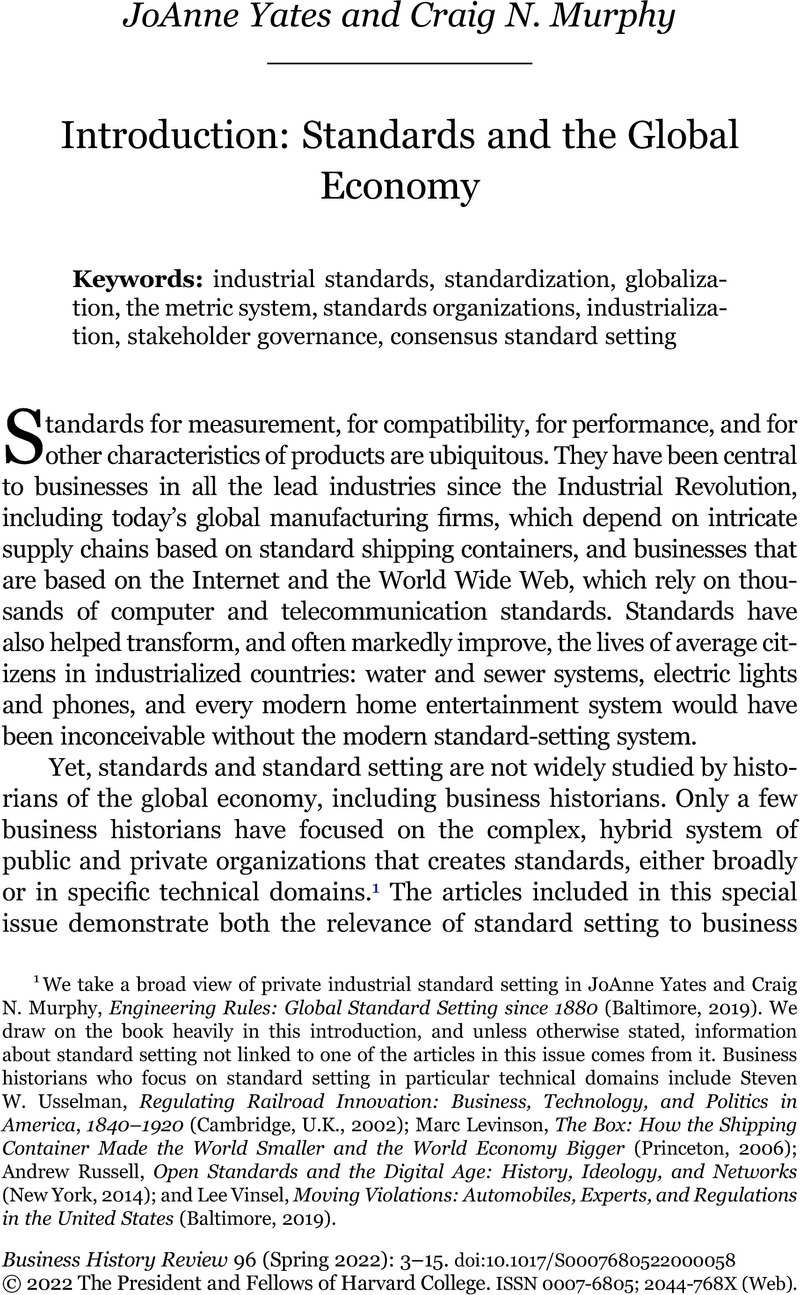Article contents
Introduction: Standards and the Global Economy
Published online by Cambridge University Press: 22 April 2022
Abstract

Keywords
- Type
- Introduction
- Information
- Business History Review , Volume 96 , Issue 1: Standards and the Global Economy , Spring 2022 , pp. 3 - 15
- Copyright
- Copyright © The President and Fellows of Harvard College 2022
References
1 We take a broad view of private industrial standard setting in JoAnne Yates and Craig N. Murphy, Engineering Rules: Global Standard Setting since 1880 (Baltimore, 2019). We draw on the book heavily in this introduction, and unless otherwise stated, information about standard setting not linked to one of the articles in this issue comes from it. Business historians who focus on standard setting in particular technical domains include Usselman, Steven W., Regulating Railroad Innovation: Business, Technology, and Politics in America, 1840–1920 (Cambridge, U.K., 2002)CrossRefGoogle Scholar; Levinson, Marc, The Box: How the Shipping Container Made the World Smaller and the World Economy Bigger (Princeton, 2006)Google Scholar; Russell, Andrew, Open Standards and the Digital Age: History, Ideology, and Networks (New York, 2014)CrossRefGoogle Scholar; and Vinsel, Lee, Moving Violations: Automobiles, Experts, and Regulations in the United States (Baltimore, 2019)CrossRefGoogle Scholar.
2 On the evolution and spread of the metric system, see Tavernor, Robert, Smoot's Ear: The Measurement of Humanity (New Haven, 2007)Google Scholar, esp. 133–35; Crease, Robert P., World in the Balance: The Historic Quest for an Absolute System of Measurement (New York, 2011)Google Scholar; and Alder, Ken, “A Revolution to Measure: The Political Economy of the Metric System in France,” in The Values of Precision, ed. Wise, M. Norton (Princeton, 1995), 39–71CrossRefGoogle Scholar.
3 For example, standards committees representing four different engineering societies cooperated to set U.S. steel rail standards around 1900. See Usselman, Regulating Railroad Innovation, 215–39; and Yates and Murphy, Engineering Rules, 3–34, 40–51.
4 See Levin, Box, as well as Yates and Murphy, Engineering Rules, 168–80.
5 These opening paragraphs draw on Abbate, Janet, Inventing the Internet (Cambridge, MA, 1999)Google Scholar; Russell, Open Standards; Russell, Andrew L., “‘Rough Consensus and Running Code’ and the Internet-OSI Standards War,” IEEE Annals of the History of Computing 28, no. 3 (2006): 48–61CrossRefGoogle Scholar; and Yates and Murphy, Engineering Rules, 242–60.
- 6
- Cited by


